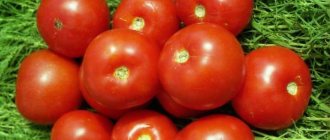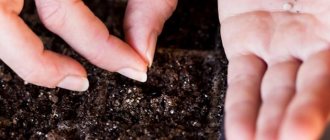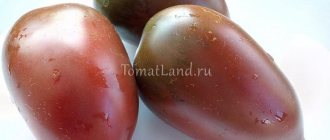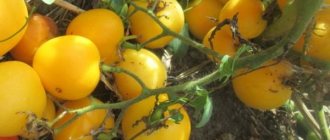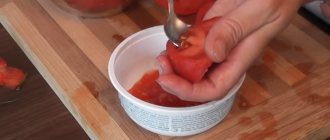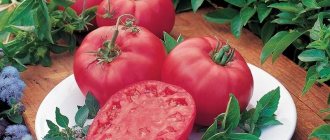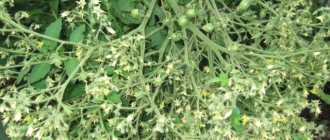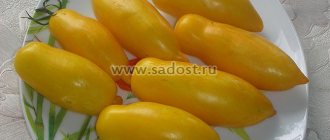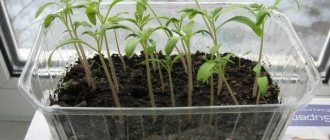Among the early ripening tomatoes, a wonderful variety stands out - Burkovsky early. Bonuses include simplicity of agricultural technology, productivity, and excellent taste.
| Height | Landing location | Ripening time | Fruit color | Fruit size | Origin | Fruit shape |
| short | Greenhouse, Open ground | Early ripening | Reds | Average | Variety | Flat-round |
History of growing tomato Burkovsky early
The seed production company is engaged in the sale of Burkovsky early tomato seeds, which made it possible to believe that it was in Siberia that this variety appeared. However, this idea is incorrect, although it is found in many sources. Burkovsky early appeared as a result of the work of scientists from the All-Russian Research Institute of Plant Growing (St. Petersburg), since 2015 bearing the name “FGBNU Federal Research Center All-Russian Institute of Plant Genetic Resources named after. N.I. Vavilova.”
The institute’s specialists consider it one of the samples “with the greatest expression of economically valuable traits,” along with such varieties as Altaiskiy ranniy, Baltiyskiy and Borodinskiy.
Unfortunately, the variety in question has not been included in the State Register of Breeding Achievements of the Russian Federation, and it can only be judged based on information from the seed manufacturer and reviews from gardeners on specialized forums. It is indicated that it is mainly planted in open ground, but in the northern regions it grows in greenhouses. It is grown both in moderately hot areas and in the conditions of Siberia and the Urals.
What do tomato fruits look like?
The fruits have a round shape. The fruit pulp is smooth and has a glossy sheen. It is also aromatic, juicy with a sour taste. Ripe red tomato. The weight of one fruit does not exceed 150 grams. Burkovsky tomatoes can be used fresh, for pickling, pickling, canning and drying. You can make ketchup, puree or sauce from tomatoes.
You may be interested in: Dates for planting tomato seedlings in open ground and greenhouses according to the garden calendar Favorable days for planting tomatoes for seedlings in 2021 according to the lunar sowing calendar Favorable days for picking tomatoes in 2021 after germination: timing of picking tomato seedlings in the table by day
Description of the tomato variety Burkovsky early
The Burkovsky early tomato is positioned as a high-yielding variety of early ripening. It is classified as determinant; the bushes reach a height of only 60 cm, but due to the large number of fruits they require tying and, preferably, plant formation. It is also possible to grow the variety without pinching; this does not affect the overall yield very much. The leaves are of normal size, green, the foliage of the bushes is moderate. The stems are not very strong, so you can simply place supports under the clusters with fruits. Fruit clusters, starting from the fifth or sixth leaf, are tied after each leaf without gaps.
The bushes do not hold the harvest well; without tying, the tomatoes lie on the ground
The fruits are red, medium size. The weight of tomatoes on one bush can be 150 g (on the lower tiers), and only 70–80 g. The shape of the fruit is regular, from round to flat-round, with slightly pronounced ribbing. The fruits have a strong shine, have a dense skin, and the number of seeds is small. Ripening begins approximately three months after emergence.
Benefits of tomato
The “Early 83” variety has proven itself on the positive side, let’s look at how it will please the gardener who decides to grow it:
- It can be grown in closed and open soil.
- Fruits will set even in bad weather conditions if the plant is grown on exhaust gas.
- The yield is good, the fruits ripen smoothly.
- The plant does not require special care.
- The fruits are stored well and can be transported over long distances.
- Universal to use.
- In warm regions, seeds can be sown in open ground.
Useful! Often the plant begins to wither not because of disease, but because of a lack of some nutrient.
A lack of nitrogen is manifested by yellowing, falling leaves, and plant growth stops. These signs can also appear at low temperatures, poor lighting, or insufficient moisture, so it is worth taking weather conditions into account. A purple tint to the leaves and stem indicates a lack of phosphorus. Iron deficiency appears on the leaves. They become pale and the veins are very green.
Characteristics of the tomato variety Burkovsky early
The Burkovsky early tomato is characterized by unpretentiousness to growing conditions and high resistance to most diseases, including late blight and tobacco mosaic virus. Able to set fruit even in unfavorable weather.
The taste of the fruit is assessed as good or excellent, the aroma is strong. The taste is dominated by sweetness, but not without the sourness characteristic of many early tomatoes. The main purpose of the harvest is salad, but excess harvest can be processed into any product. The variety is suitable for both pickling and drying.
Burkovsky early has a high yield; with proper care, up to 3 kg of tomatoes can be harvested from one bush, which, when planted tightly, allows you to get up to 15 kg of produce per square meter. Tomatoes tolerate transportation and long-term storage well, which arouses the interest of farmers who grow vegetables for sale.
The Burkovsky early tomato fruits look good: smooth, without flaws, quite marketable
Thus, the most important advantages of the Burkovsky early tomato are complex resistance to diseases and vagaries of weather, unpretentiousness, and ease of care. Productivity is also good. The quality of its fruits is apparently not the best: among early-ripening tomatoes you can currently find many varieties with an exquisite taste. However, those that would combine only positive qualities probably do not yet exist.
Tomato Early 83 proves that old varieties are no worse than new hybrids
Some gardeners saw and became interested in Early 83 for the first time; others remember that their grandmother grew this variety; and still others have been planting tomatoes for many years in a row and see no equal to them in many qualities. If representatives of different generations like a variety, it means there is something in it worthy of our attention.
Description of the tomato variety Early 83
Early 83, although it was included in the State Register of Plants only in 2015, is in fact a very old domestic variety, a descendant or coeval of Bely Nalivka and Moskvich. The Moscow region is responsible for the safety of the variety. The tomato has passed tests and received permission to be grown in all Russian regions, in open ground.
Infographics: characteristics of the tomato variety Early 83 according to the State Register
Characteristics of the tomato variety Early 83 according to the State Register
The bush of this variety is determinate, stops growing after reaching a height of 50–60 cm. It ties 2–3 clusters on the main stem, the rest on the stepsons. The fruits ripen 95–105 days after emergence. Tomatoes are red, have a round shape, flattened at the poles. Their size is average, the weight of one is 80–150 g, and there are 4–5 seed chambers inside. The taste is the same - classic tomato.
Early 83 tomatoes have a flattened shape
Early 83 is suitable for preparing salads, canning whole fruits, processing into juice and lecho. The variety is unpretentious, manages to finish fruiting before the onset of late blight and other fungal diseases, is distinguished by its reliability and easy ripening in any climate zone, the tomatoes tolerate transportation well. Productivity is 6–7.5 kg/m², which is quite a lot for such a short-growing tomato.
Early 83 is a low-growing variety, but produces a lot of fruit
Why Early 83 is better or worse than other determinate tomatoes
It would be fair to consider the strengths and weaknesses of Early 83 against the background of the same compact retro tomatoes, which, by the way, are no worse in taste and yield than modern hybrids from the same category (determinant):
- White filling 241 differs from Early 83 in the shape of the fruit, it is round, and also in its susceptibility to late blight.
White filling is also an abundant tomato, but suffers from late blight
Moskvich has a very compact and strong bush, but the fruits are small
Volgogradsky has classic-sized, meaty tomatoes
Ground Gribovsky has fruits up to 100 g, the stalk has a long-lasting stain
Early 83 is interesting due to its combination of several positive characteristics: early ripening, excellent taste, transportability, disease resistance. In addition, the fruits are not small, but of the usual tomato size. Not every modern Dutch hybrid of the determinate type possesses such qualities in combination. At the same time, the seeds of Early 83 are available in any store for summer residents; they are very cheap.
I noticed a trend in stores: old domestic varieties are sold in simple white packages without pictures, and new imported hybrids with the same characteristics, but advertised, are sold in colorful packages of 5 pieces and are expensive. Marketing ploy: we perceive an expensive product in bright packaging as something better.
Features of cultivation
Sow early 83 for seedlings in late March - early April. In the phase of 1–2 true leaves, pick out. If the lower leaves of growing seedlings (not cotyledons) begin to turn yellow, then feed them with a fertilizer containing nitrogen: ammonium nitrate, urea, horse manure extract, nettle infusion or any modern concentrate that contains humic acids (humus).
Plant seedlings in the garden that are hardened, that is, accustomed to open-air conditions. Scheme for this variety: 30x50 cm or 40x40 cm. To avoid fertilizing after planting, pour a handful of humus and a teaspoon of superphosphate and potassium sulfate into each hole.
Video: planting low-growing tomatoes in the ground
Care after planting consists of watering and garter. Early 83 needs support, otherwise the bushes will collapse, the tomatoes will end up on damp ground, and can become prey for snails, slugs or pathogenic fungi. You can do without forming, then more fruits will grow, but small ones, they will begin to ripen later than the stated period. To enlarge tomatoes, break out the lower shoots up to the first flower cluster and thin out the crowns of the bushes. On each plant, leave 4-5 clusters of the first ones to set. Then the tomatoes will fill to the maximum size for the variety and will be juicy and tasty.
Features of agricultural technology
If you do not want to grow seedlings, this tomato can be sown with seeds directly into the garden bed, especially in warm regions. True, at the same time it will cease to be early, so they still try to prepare the seedlings. If you have a greenhouse, you can sow seeds for seedlings in it; the seedlings do not require heat, but you need to sow the seeds of this tomato in early April, when in many areas it is already relatively warm.
Burkovsky early seedlings do not outgrow, there are few problems with them, you only need to water them moderately, and in case of fertile soil you can do without fertilizing. You can plant it in a permanent place at the age of one and a half months; if you wait up to two months, it will already have buds. The pattern can be quite dense: five bushes per square meter is normal, and six is also possible.
Despite the relative cold resistance of the variety, if at the time of planting there is still a threat of a strong drop in temperature, and even more so of frost, the plantings must be temporarily covered with spunbond: the seedlings are stocky and short, this is easy to do.
To grow seedlings, you don’t need to take separate cups, which saves space
Plant care is ordinary; this variety does not require highly qualified gardeners. Water the tomatoes as needed, avoiding waterlogging of the soil. Until the fruits begin to ripen, the soil is kept moderately moist, then slight drying is recommended. Since the variety is early, they only have time to feed it 2–3 times. The scheme is standard: complex fertilizer or mullein solution two weeks after planting the seedlings, potassium-phosphorus fertilizers at the beginning of fruit growth and, possibly, an ash solution at the very beginning of their browning.
This variety can be grown without forming a bush, but those who like order in everything carry out stepsoning, leaving the two strongest lower stepsons, that is, leading the bush into three stems. Tying the bush to a peg is advisable: a heavy harvest may cause the plant to fall, and the tomatoes will have to be collected from the ground. There is no point in harvesting crops in an unripe state: tomatoes ripen perfectly on the bushes, and it is in the sun that they gain all the flavor and aroma required by the variety.
The formation of a bush, if carried out, is quite traditional
Agricultural technology and care
In the conditions of the middle zone, tomatoes of the Early 83 variety grow successfully under film covers and in greenhouses of various formats, as a seal for tall tomatoes. They are grown by seedlings in cold, short summer conditions.
In regions with warm climates, this tomato variety is easy to care for. Seeds are sown directly into the ground. This method saves labor and time on growing seedlings, picking, and the survival of plants in a new place.
- With the seedling method, tomato seeds are sown in the third ten days of March or early April. The seeds are germinated at a temperature of 25 degrees, after placing them on lightly compacted soil under a 1 cm layer of peat mulch or soil mixture. It is recommended to pour the top layer with warm water through a sieve and cover with plastic wrap.
- With the emergence of seedlings, the film is removed and the seedlings are transferred closer to the light with an air temperature of 15-16 degrees for a period of 5-7 days. The optimal temperature for further growth and full development of seedlings should be maintained at about 20-22 degrees.
- Plants with the appearance of 2 permanent leaves are planted in separate cups or boxes, according to a 10 x 10 cm pattern. Caring for seedlings consists of timely moistening the soil and maintaining light and temperature conditions.
- The seedlings are transplanted to a permanent place at the age of 60-65 days. By this time the bushes should have 5-6 permanent leaves and at least one flower cluster. Planting pattern 50 x 40 cm. Low bushes do not need support.
- With the appearance of 4-5 brushes, the plant limits its growth on its own; there is no need to form a bush. But for faster fruit ripening, newly appearing side shoots should be removed several times a season. They pose serious competition, drawing moisture and nutrients onto themselves.
- Care consists of keeping the soil moist, regular weeding, and hilling the bush. Loosening should be done after watering around the plant and between the rows. Feed as needed, up to three times during the growing season.
The tomato variety was registered in 1967 and over such a significant period has been tested in the fields of vegetable farms and private garden plots. Anyone who has planted early-ripening tomatoes knows how much joy the first, long-awaited fruits bring.
Proven varieties with an excellent reputation must be present on our sites. After all, they guarantee a harvest and rarely fail even in difficult weather conditions. You can prepare “Early 83” tomato seeds yourself, because they do not lose their germination for a fairly long period, about 5-6 years. Low-growing determinate tomatoes with such powerful disease protection will require minimal care.
Reviews of tomato variety Burkovsky early
Sibsadovsky varieties will be good for Omsk. In open ground you can use Velmozha, Khlebosolnye, Sevryuga, Burkovsky early. Pepper https://www.forumhouse.ru/threads/266109/page-51
Well, I don’t know, maybe it’s because I don’t have a good relationship with short-growing plants, but there was nothing like that: neither a mass of 150-200 grams (the average weight turned out to be about 100 grams), nor a high yield... That’s what ties the brushes through the leaf - it’s true. The leaves were kind of twisted, the bushes were stunted, the fruits tasted sour. I didn’t even take a photo when it was ripe—there was nothing to look at. I won’t plant Cherry https://www.tomat-pomidor.com/forums/topic/209-%D0%B1%D1%83%D1%80%D0%BA%D0%BE%D0%B2%D1% 81%D0%BA%D0%B8%D0%B9-%D1%80%D0%B0%D0%BD%D0%BD%D0%B8%D0%B9/
We really liked the Burkovsky early tomato in 2017, we needed to throw a few bushes under the feet of the Indians in the greenhouse, I bought the first one that came to hand (Actually, I mixed up the name with “Burakersky favorites.” As a salad tomato that year, it was our favorite . There were poor bushes lying around, I practically didn’t tie them up... So, they practically picked them from the ground. Tasty, sweet, aromatic. The size clearly didn’t reach 200 g, but that’s not the main thing). Tomato expert https://www.tomat-pomidor.com/forums/topic/209-%D0%B1%D1%83%D1%80%D0%BA%D0%BE%D0%B2%D1%81%D0% BA%D0%B8%D0%B9-%D1%80%D0%B0%D0%BD%D0%BD%D0%B8%D0%B9/
Favorite early tomato, very tasty, sweet, aromatic! Ivanna https://www.tomat-pomidor.com/forums/topic/209-%D0%B1%D1%83%D1%80%D0%BA%D0%BE%D0%B2%D1%81%D0% BA%D0%B8%D0%B9-%D1%80%D0%B0%D0%BD%D0%BD%D0%B8%D0%B9/
Burkovsky early matches the description, height is about half a meter, I liked the taste. Mistral https://forum.prihoz.ru/viewtopic.php?t=5872&start=105
I would recommend the Burkovsky tomato variety. Early. The taste is good. Katie https://forum.tvoysad.ru/viewtopic.php?t=5488&start=30
Burkovsky early - ultra early, that's all the advantages. Elena https://mamasoldata.mybb.ru/viewtopic.php?id=985&p=4
How to grow a variety and what care should be
The advantage of Burkovsky is that it is an early tomato. The variety has virtually no disadvantages. To get high yields, it is worth growing the crop using seedlings. It is necessary to prepare seedlings 60 days before they are planted in the soil. Sowing seedlings in a greenhouse should be done in the first half of April.
To grow seedlings you need:
- use universal primer;
- seeds should be sown to a depth of no more than 2 cm;
- use film for greenhouse effect;
- maintain the air temperature in the room at least 22 degrees;
- when the first shoots appear, you need to use fluorescent lamps, and 7 days before planting in open ground, begin to harden the seedlings;
- ensure regular watering.
When grown in open ground, no more than 5 tomato bushes should be planted per square meter. The first brush appears after the 5th leaf. The plant does not require special care, but it is important to follow the following rules:
- the plant should receive regular watering with warm water +20-30 degrees;
- Fertilizing with mineral fertilizers should be done at least 6 times per season. Mullein or chicken droppings should be used as fertilizing. You can also use potassium and phosphorus fertilizers;
- weeds must be removed from the soil;
- the soil requires loosening;
- mature bushes require tying to a support.
When planting a plant in non-chernozem soil, it is important that frosts have passed. This period begins in the middle of the first ten days of June. If the tomato is planted in a greenhouse, then planting can be done on May 15-20.
